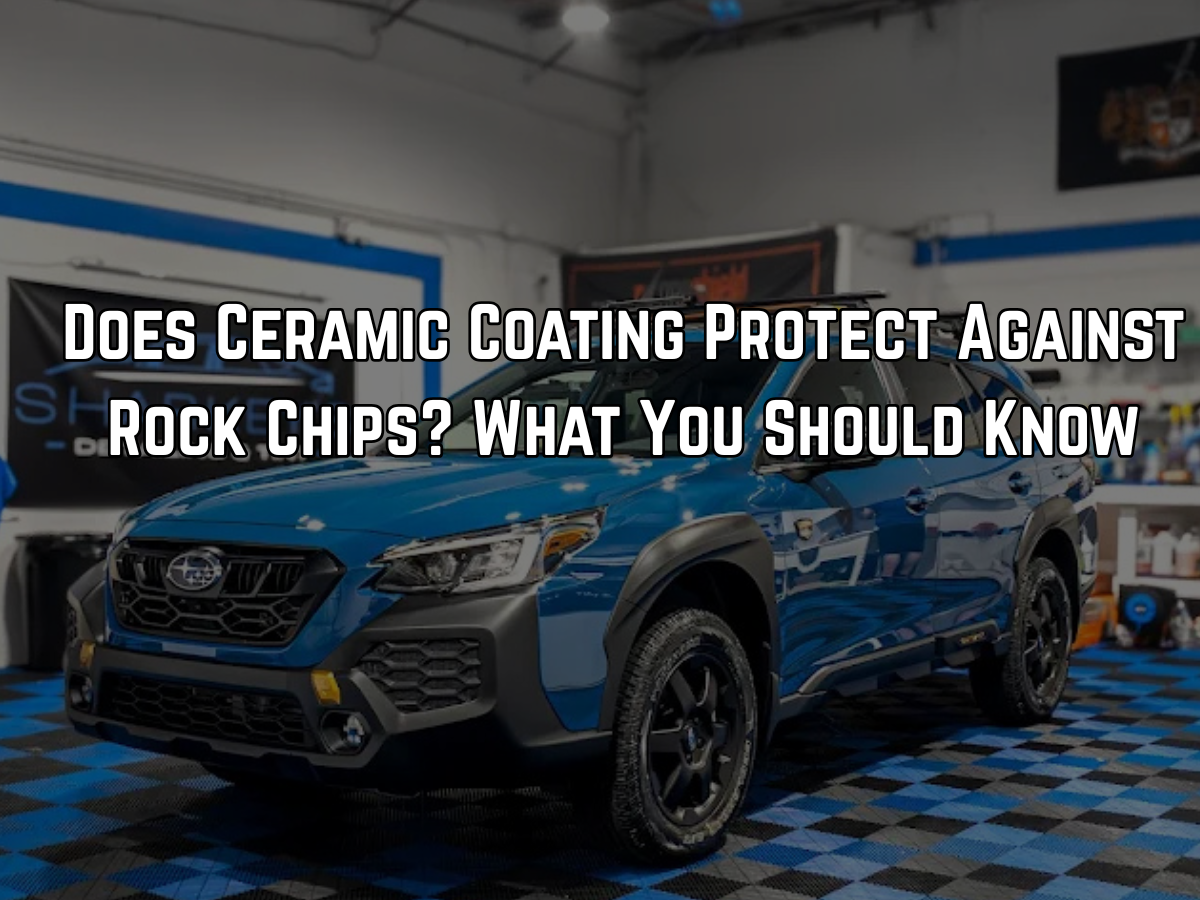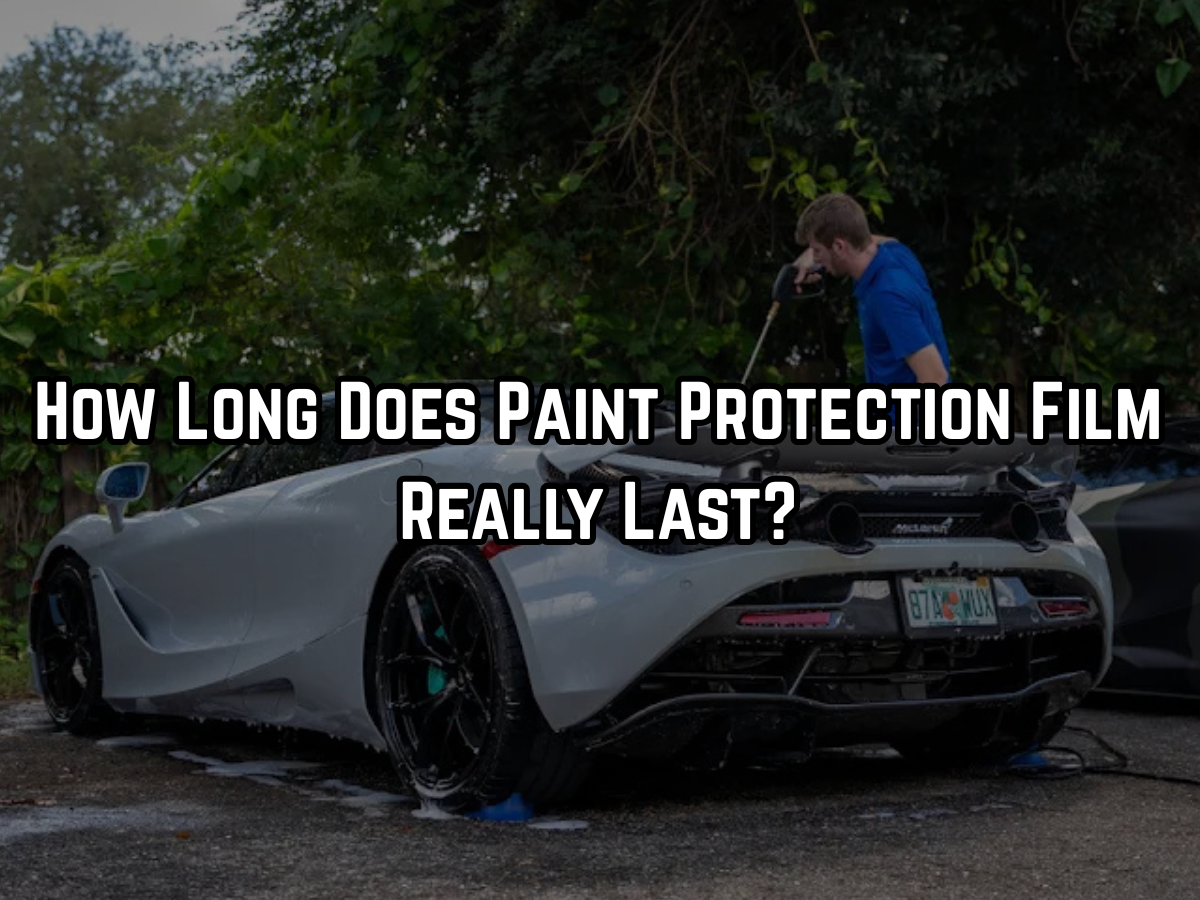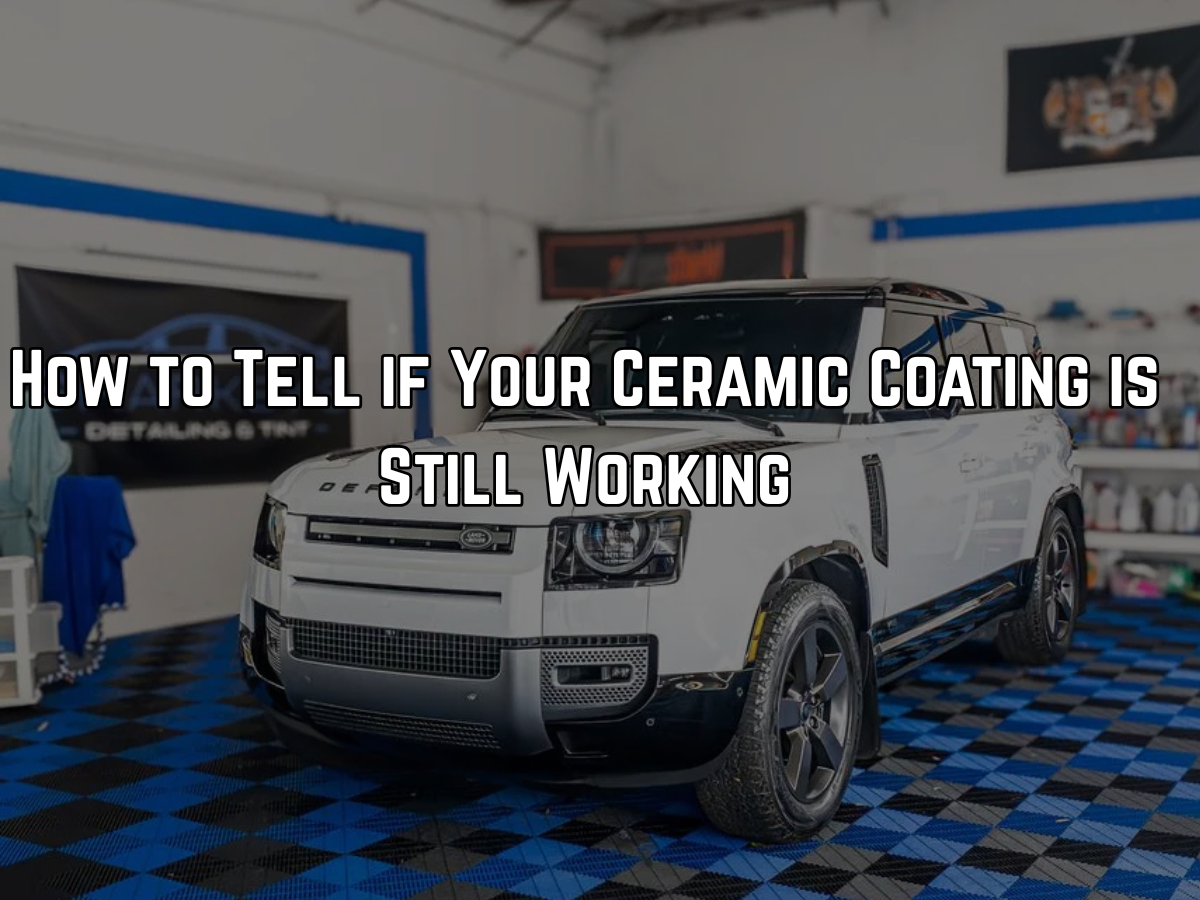Does Ceramic Coating Protect Against Rock Chips? What You Should Know
You're considering ceramic coating for your car, and someone mentioned it protects against rock chips. Or maybe you already have a coating and you're wondering if those chips on your hood mean the coating failed. Either way, you need the real answer, not marketing hype.
The Straight Answer
Ceramic coating does not protect against rock chips. The coating is typically 2 to 5 microns thick (about 1/10th the thickness of a human hair), which is far too thin to absorb the kinetic energy from a rock hitting your paint at highway speeds. What ceramic coating does protect against is chemical damage, UV degradation, water spotting, and light scratches from washing. For actual rock chip protection, you need paint protection film (PPF), which is a thick polyurethane layer designed to absorb impacts.

Understanding What Ceramic Coating Actually Does
Ceramic coatings create a hard, glass-like layer over your clear coat through chemical bonding. The silicon dioxide (SiO2) or similar compounds form a semi-permanent bond with your paint's surface. This creates excellent protection against specific threats.
The coating excels at preventing chemical etching from bird droppings, bug acids, and tree sap. It makes your paint hydrophobic, causing water to bead up and roll off, which reduces water spotting. The hard surface resists light scratching from improper washing techniques better than bare clear coat. It also blocks UV rays that would otherwise oxidize and fade your paint over time.
But here's what it doesn't do: provide a cushion against physical impacts. When a rock traveling at 60 mph hits your paint, it carries significant kinetic energy. That energy needs somewhere to go. A coating that's only a few microns thick simply can't absorb that force.
Why Rock Chips Happen Regardless of Coating
Rock chips occur when debris on the road gets kicked up by tires and impacts your paint at high velocity. The force is concentrated on a tiny point, typically smaller than the head of a pin. That concentrated force exceeds what your clear coat can withstand, causing it to crack and chip away.
Your factory clear coat is usually 40 to 60 microns thick. Even that's not enough to stop rock chips. A ceramic coating adds maybe 2 to 5 microns on top of that. The math just doesn't work out. You're adding 5% to 10% more thickness, which sounds like something until you realize the original layer wasn't stopping chips either.
Think of it like this: if someone throws a baseball at a window, putting a thin coat of wax on that window won't stop it from breaking. The coating might make the window more scratch-resistant or easier to clean, but it won't change how the glass responds to impact.
The Thickness Factor Everyone Misses
Let's put coating thickness in perspective with actual numbers. A typical ceramic coating measures 2 to 5 microns thick once cured. Your clear coat measures 40 to 60 microns. A human hair is about 70 microns thick. Paint protection film? That's 150 to 200 microns thick, roughly 40 times thicker than ceramic coating.
That massive difference in thickness explains why PPF stops rock chips while ceramic coating doesn't. PPF has enough material to absorb and distribute the impact energy. It can deform slightly on impact, then return to its original shape through self-healing properties. Ceramic coating has no such capability.
Some people assume that because ceramic coating is "hard," it must protect against impacts. Hardness and impact resistance are different properties. Diamond is the hardest natural material, but if you hit it with a hammer at the right angle, it'll shatter. Ceramic coatings are hard in terms of scratch resistance, not impact absorption.
What Ceramic Coating Actually Protects Your Paint From
Just because ceramic coating doesn't stop rock chips doesn't mean it's not valuable. The protection it offers is significant for other types of damage.
- Chemical resistance is probably the coating's strongest benefit. Acidic contaminants like bird droppings, bug splatter, and acid rain sit on top of the coating rather than etching into your clear coat. In Florida's environment, where bugs are a year-round problem and afternoon rain is almost daily, this protection matters.
- UV protection prevents oxidation and fading. The coating blocks harmful UV rays from penetrating to your paint layers. This is especially relevant in Sarasota's intense sun. Unprotected paint can start showing UV damage within 2 to 3 years. Coated paint maintains its gloss and color much longer.
- Minor scratch resistance helps during regular washing. Those light scratches from automated car washes or wash mitts with embedded dirt? The coating's hard surface resists them better than bare clear coat. You're not eliminating wash-induced swirl marks completely, but you're reducing them.
- Water behavior changes with a coating. The hydrophobic surface causes water to bead tightly and sheet off easily. This reduces water spotting from hard water and makes your car easier to wash and dry.
Paint Protection Film: The Real Rock Chip Solution
If you want actual protection against rock chips, paint protection film is what you need. PPF is a thick, clear polyurethane film applied to high-impact areas of your car. It's designed specifically to take hits that would otherwise chip your paint.
The film works through its thickness and material properties. When a rock hits PPF, the polyurethane absorbs and distributes the impact energy across a larger area. The film might show a mark or indent, but your paint underneath remains untouched. Many modern PPFs have self-healing properties where light scratches and indents disappear with heat.
PPF typically goes on the front bumper, hood, fenders, side mirrors, door edges, and rocker panels. These are the areas that catch the most road debris. You can do a full car wrap if you want maximum protection, but most people focus on the front end where rock chips concentrate.
The downside? PPF costs significantly more than ceramic coating because of material costs and installation complexity. But if rock chip protection is your priority, it's the only real option.
Combining Ceramic Coating and PPF
Here's where things get interesting. You can actually combine both products for layered protection. Many detailers apply PPF first to high-impact areas, then ceramic coat over the PPF and the rest of the car.
This combination gives you impact resistance from the PPF and all the chemical, UV, and water-repellent benefits of ceramic coating. The coating also makes the PPF easier to maintain and can enhance its clarity and gloss.
Some PPF products come with a factory-applied coating. In those cases, adding another ceramic coating on top is optional. The factory coating usually isn't as durable or hydrophobic as a premium standalone ceramic coating, so some people still add one.
The PPF protects the paint from rock chips. The ceramic coating protects both the exposed paint and the PPF from chemical damage and makes everything easier to clean. It's a comprehensive protection strategy, though it represents a bigger investment than either product alone.
Common Misconceptions About Ceramic Coating Hardness
Marketing language around ceramic coatings often mentions "9H hardness," which confuses people. This refers to the pencil hardness scale used in coating testing. It means a 9H pencil won't scratch the coating, which is good for scratch resistance but has nothing to do with impact protection.
Some assume that a harder coating equals better protection across the board. That's not how it works. Hardness specifically relates to scratch and mar resistance. A material can be extremely hard but still brittle and susceptible to impact damage.
Think about glass versus rubber. Glass is much harder than rubber on the hardness scale, but if you drop both from the same height, the glass breaks while the rubber bounces. Hardness and impact resistance are separate properties. Ceramic coating optimizes for hardness and chemical resistance, not impact absorption.
What Happens When You Get Rock Chips with a Coating
If you have ceramic coating and get a rock chip, the chip goes straight through the coating and into your clear coat, just like it would without coating. The coating doesn't prevent the chip, but it does continue protecting the paint around the damaged area.
One benefit of having a coating is that it makes spotting and addressing chips easier. On bare paint, chips can develop rust quickly, especially in Florida's humid, salty environment. The coating around the chip provides a barrier that slows down corrosion spreading from the chip site.
When you get a chip, you should touch it up quickly. Use paint touch-up pens or professional chip repair to seal the exposed metal. The ceramic coating will continue protecting the rest of your paint while the touch-up paint handles the damaged spot.
Some people worry that the coating makes chip repair harder. It doesn't, really. The repair process is the same whether you have coating or not. Clean the chip, apply primer if needed, add paint, and seal it. The coating around the chip might need light buffing if the repair gets messy, but that's minor.
Where Rock Chips Actually Happen Most
Certain areas of your car take way more abuse than others. The front bumper catches everything kicked up by your own tires and the vehicles ahead of you. It's the most vulnerable panel on your car.
The hood's leading edge gets hit constantly at highway speeds. Rocks bouncing up from the road strike this area at acute angles, which increases chip likelihood. The center of the hood sees less damage, but the first 6 to 12 inches from the front edge get hammered.
Fenders and side mirrors catch debris from passing trucks and cars in adjacent lanes. Those rocks hit from the side at lower angles, but they still chip paint.
Door edges and rocker panels get chips from parking lot incidents and road debris at lower speeds. These tend to be different from highway rock chips, but they're still impact damage that ceramic coating won't prevent.
If you're serious about rock chip prevention, these are the areas where PPF makes the most sense. Protecting just the front bumper, hood edge, and fenders covers probably 80% of the rock chip risk you face.
Highway Driving and Rock Chip Risk
Highway driving amplifies rock chip risk significantly. At 70 mph, even a small pebble carries enough energy to chip paint on impact. Following too closely behind other vehicles increases your exposure to kicked-up debris.
Trucks carrying gravel or construction materials are particular hazards. Even when the load is covered, small pieces work loose and fall off. Following a dump truck on the highway is asking for paint damage.
Construction zones create elevated risk because of loose debris on the road surface. Fresh asphalt often has loose aggregate that gets kicked up by tires. If you drive through construction zones regularly, you're going to get more rock chips than someone who sticks to smooth residential roads.
Ceramic coating doesn't change any of this calculus. The protection you need is PPF if highway driving is part of your regular routine.
The Cost-Benefit Reality Check
Ceramic coating costs less than PPF but doesn't protect against rock chips. That's not a criticism, just reality. Different products serve different purposes.
If rock chips are your main concern and you do lots of highway driving, invest in PPF for at least the front end of your car. You'll get the protection you actually need.
If you want chemical protection, UV blocking, easier cleaning, and scratch resistance, ceramic coating delivers excellent value. Just don't expect it to stop rock chips.
Many people do both: PPF on high-impact areas and ceramic coating over the PPF and remaining panels. This gives comprehensive protection but costs more upfront. Whether that's worth it depends on how much you value paint preservation and how long you plan to keep the car.
Maintaining Your Paint Despite Rock Chips
Even with the best protection, some rock chips are probably inevitable if you drive regularly. The question becomes how to minimize their impact and keep your paint looking good long-term.
Regular inspection helps. Walk around your car every few weeks and look for new chips, especially on the front bumper and hood. Catching them early means you can touch them up before rust starts.
Touch-up paint is worth keeping in your garage. Most manufacturers sell paint pens or small bottles matched to your car's color code. The repair won't be invisible, but it seals the chip and prevents corrosion.
Professional chip repair services can make chips nearly invisible through careful color matching, paint application, and clear coat blending. If appearance matters significantly to you, professional repair is worth considering for visible chips.
Keep your ceramic coating maintained even if you get chips. The coating's protection against chemical damage and UV degradation continues working on all the unchipped areas. Regular ceramic coating maintenance ensures maximum longevity.
When to Consider PPF Over or Alongside Coating
If you just bought a new car and plan to keep it for 10 years or more, PPF makes financial sense. Preventing chips is cheaper than fixing them repeatedly or dealing with reduced resale value from a chipped-up front end.
If you live in an area with harsh road conditions, gravel roads, or heavy construction traffic, PPF pays for itself quickly. The alternative is living with increasing paint damage or spending money on repairs and paint correction.
If you have a high-end or exotic car, PPF becomes almost mandatory. The paint on these vehicles costs more to repair, and their resale values depend heavily on condition. Protecting that investment makes sense.
You can also do PPF now and add ceramic coating later, or vice versa. They're not mutually exclusive, and the order depends on your immediate priorities and budget.
The Bottom Line on Coatings and Rock Chips
Ceramic coating won't stop rock chips. That's not what it's designed to do. It's a chemical and environmental protection product, not a physical armor. The coating is too thin to absorb impact energy from road debris.
For actual rock chip protection, you need paint protection film. PPF has the thickness and material properties to take hits that would otherwise damage your paint. It's more expensive than ceramic coating but serves a completely different protective purpose.
The best approach for comprehensive paint protection combines both: PPF on high-impact areas like the front bumper and hood, and ceramic coating over the PPF and remaining paint. This gives you impact resistance where you need it most, plus chemical and UV protection everywhere.
If you're trying to decide between the two and can only do one, base your decision on your actual driving conditions and primary concerns. Lots of highway driving and rock chip anxiety? Get PPF. Chemical staining, water spotting, and cleaning difficulty? Ceramic coating makes more sense.
For more information on protecting your vehicle's paint, explore resources on ceramic coating and paint protection options available in the Sarasota area.




